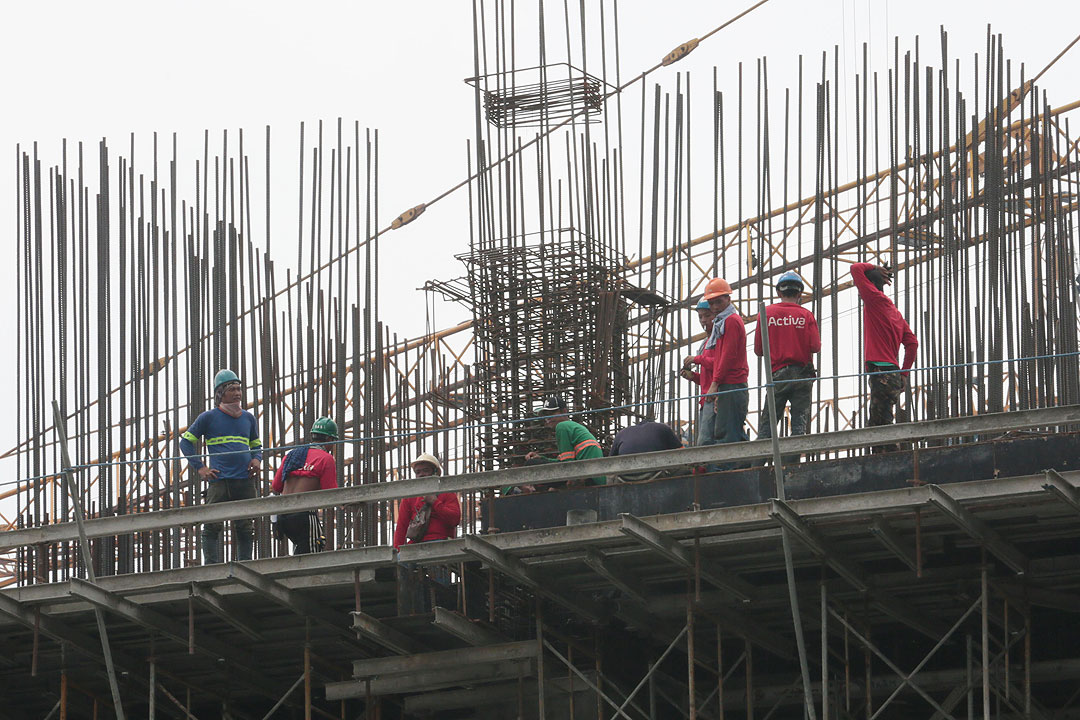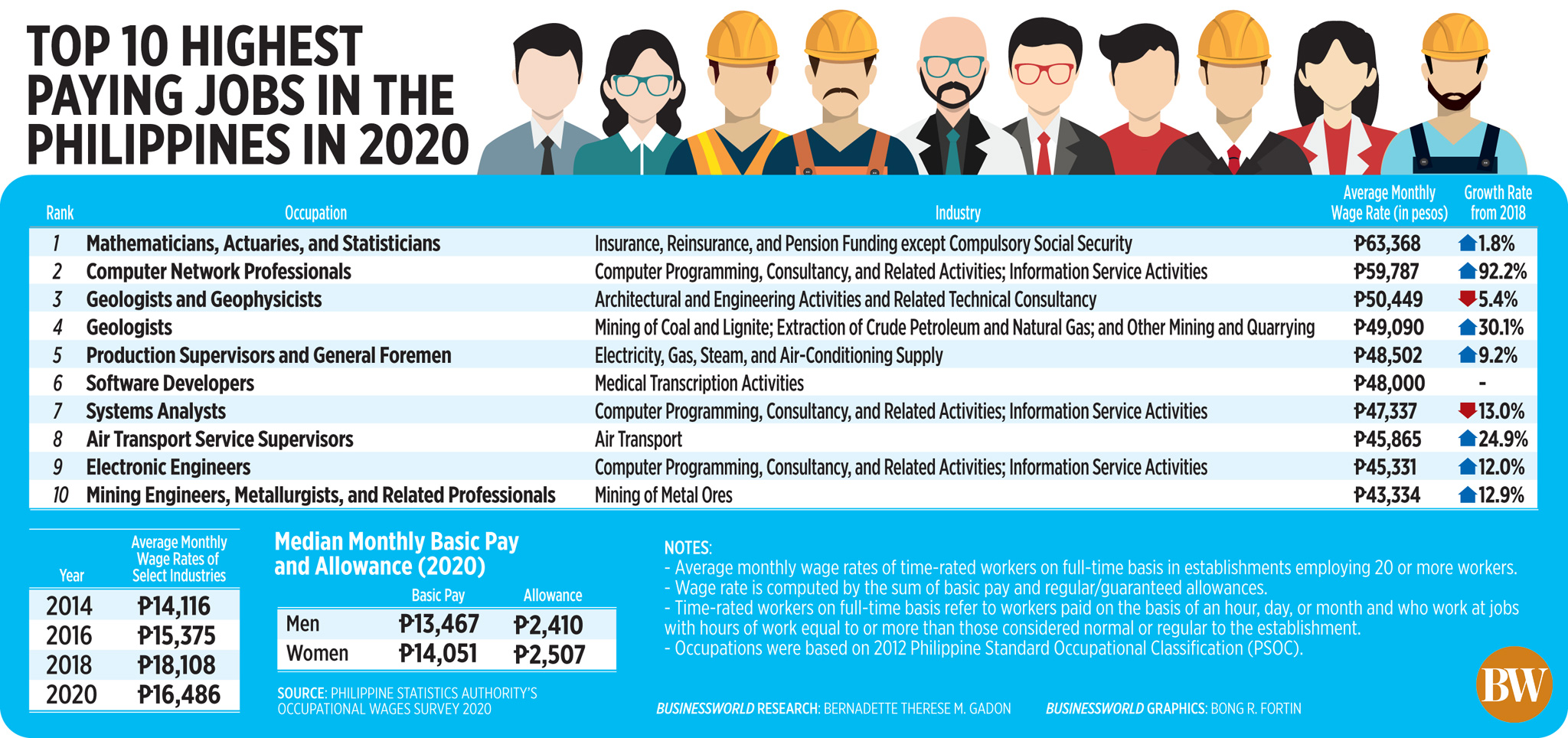Average monthly wages decline by 9%

By Bernadette Therese M. Gadon, Researcher
AVERAGE MONTHLY WAGE rate of selected occupations decreased by almost a tenth in 2020, reflecting the economy’s record contraction due to the coronavirus pandemic.
The Philippine Statistics Authority (PSA) on Wednesday said the average monthly wages of time-rated workers across 190 monitored jobs in the country declined by 9% to P16,486 in 2020 from P18,108 in 2018, citing the Occupational Wages Survey (OWS).
On the other hand, the median monthly basic pay inched up by 0.6% to P13,646 in 2020 from P13,559 in 2018.
Conducted every two years, OWS is a nationwide survey of establishments employing 20 or more workers. It monitors the wage rates of two benchmark occupations — accounting and bookkeeping clerks and unskilled workers — and at most 11 occupations in each of the predetermined 55 out of 71 industries.
“The main objective of the 2020 OWS is to generate wage statistics as critical inputs to policies on wage and salary administration and wage determination particularly in wage-fixing, price policies and collective bargaining negotiations,” the PSA said.
For the 2020 OWS, a total of 190 industry-specific jobs were monitored. The reference period covers the pay period that includes Aug. 31, 2020.
Among the 18 industries covered in the survey, mining and quarrying workers saw an increase in their median monthly basic pay by 14.5% to P13,272 in 2020 from P11,590 in 2018. Workers in the electricity, gas, steam, and air-conditioning supply sector saw a 10.7% rise in pay to P27,253 from P24,627, while those in human health and social work activities saw wages increase by 9.8% to P14,721 from P13,411.
Meanwhile, workers in the following industries saw a decline in their median basic pay in 2020: financial and insurance activities by 13.5% (to P15,986 in 2020 from P18,486 in 2018); real estate activities by 9.7% (P16,238 from P17,989); and wholesale and retail trade, repair of motor vehicles and motorcycles by 5.3% (P12,592 from P13,299).
In terms of allowances, the PSA reported a 43.1% rise in median monthly allowances across all industries amounting to P2,456 in 2020 from P1,716 in 2018.
The survey also identified the top 10 highest-paying occupations in the country, with mathematicians, actuaries, and statisticians leading with P63,368 per month, followed by computer network professionals (P59,787 per month), and geologists and geophysicists (P50,449 per month).
Economists largely blamed the decline in monthly average pay to the fallout brought by the coronavirus disease 2019 (COVID-19) pandemic.
Since March 2020, the Philippines has implemented quarantine restrictions to contain the spread of COVID-19, resulting in reduced mobility for workers.
The strict lockdowns battered the economy, which posted a record 9.6% contraction in 2020. Philippine economy rebounded last year with a gross domestic product growth of 5.6%.
Some companies have since then implemented remote or hybrid work setups.
“The decline in productivity due to work stoppages associated with lockdowns and mobility restrictions contributed to the decline in the average monthly wage rate,” University of Asia and the Pacific Senior Economist Cid L. Terosa said in an e-mail. “Also, the average monthly wage rate fell because the supply of workers far exceeded the demand for them.”
UnionBank of the Philippines, Inc. Chief Economist Ruben Carlo O. Asuncion said that the results of the OWS survey showed how other occupations decreased in the ranks, specifically on jobs that were heavily affected by the pandemic such as airline-related occupations.
“I noticed that one specific highest paid job missing on the list is the airline pilot and it is not hard to figure out why. The pandemic has practically obliterated the job and related jobs and would definitely take more time for the job to come back,” he said in an e-mail exchange.
Despite the improvement in the median basic pay and allowances in 2020, this did not lead to the creation of more jobs, Mr. Terosa said.
“Clearly, occupations requiring higher level skills sets received the highest pay. The pandemic did not affect occupations that can easily take advantage of the shift towards different working arrangements and technology-based tasks,” he said.
Likewise, Mr. Asuncion noted that the increase is only “temporary.” “It is fitting to note that full-time jobs have declined and part-time jobs grew during the height of the pandemic. There was job creation, but they are more temporary and time-bound,” he said.
Both economists expect a rebound both in the average and median monthly basic pay of the Filipino workers in the next round of the OWS as the economy gradually picks up. They also see an increase in the technology-related jobs going forward.
“In the new normal, occupations involving remote work, e-commerce, automation and related technology will be paid more highly than the rest,” Mr. Terosa said. “Demand for high-wage jobs that require greater education, intensive training, and flexible skills will continue to grow.”
“Overall, technology and data science jobs will lead the way,” Mr. Asuncion said.




